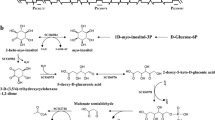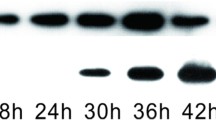Abstract
The homologous transcriptional regulators ScbR and ScbR2 have previously been identified as γ-butyrolactone (GBL) and antibiotic receptors, respectively. They regulate diverse physiological processes in Streptomyces coelicolor in response to GBL and antibiotic signals. In this study, ScbR and ScbR2 proteins were shown to interact using a bacterial two-hybrid system where adenylate cyclase activity was reconstituted in Escherichia coli BTH101. These ScbR/ScbR2 interactions in S. coelicolor were then demonstrated by co-immunoprecipitation. The ScbR/ScbR2 heterodimer was shown to co-exist with their ScbR and ScbR2 respective homodimers. When potential operator targets in S. coelicolor were investigated, the heterodimer was found to bind in the promoter region of sco5158, which however was not a target for ScbR or ScbR2 homodimers. These results revealed a new mechanism of regulation by ScbR and ScbR2 in S. coelicolor.



Similar content being viewed by others
References
Ahn SK, Cuthbertson L, Nodwell JR (2012) Genome context as a predictive tool for identifying regulatory targets of the TetR family transcriptional regulators. PLoS One 7:e50562. doi:10.1371/journal.pone.0050562
Akpe San Roman S, Facey PD, Fernandez-Martinez L, Rodriguez C, Vallin C, Del Sol R, Dyson P (2010) A heterodimer of EsxA and EsxB is involved in sporulation and is secreted by a type VII secretion system in Streptomyces coelicolor. Microbiology 156:1719–1729. doi:10.1099/mic.0.037069-0
Al-Bassam MM, Bibb MJ, Bush MJ, Chandra G, Buttner MJ (2014) Response regulator heterodimer formation controls a key stage in Streptomyces development. PLoS Genet 10:e1004554. doi:10.1371/journal.pgen.1004554
Bailey TL, Boden M, Buske FA, Frith M, Grant CE, Clementi L, Ren J, Li WW, Noble WS (2009) MEME SUITE: tools for motif discovery and searching. Nucleic Acids Res 37:W202–W208. doi:10.1093/nar/gkp335
Battesti A, Bouveret E (2012) The bacterial two-hybrid system based on adenylate cyclase reconstitution in Escherichia coli. Methods 58:325–334. doi:10.1016/j.ymeth.2012.07.018
Bentley SD, Chater KF, Cerdeno-Tarraga AM, Challis GL, Thomson NR, James KD, Harris DE, Quail MA, Kieser H, Harper D, Bateman A, Brown S, Chandra G, Chen CW, Collins M, Cronin A, Fraser A, Goble A, Hidalgo J, Hornsby T, Howarth S, Huang CH, Kieser T, Larke L, Murphy L, Oliver K, O’Neil S, Rabbinowitsch E, Rajandream MA, Rutherford K, Rutter S, Seeger K, Saunders D, Sharp S, Squares R, Squares S, Taylor K, Warren T, Wietzorrek A, Woodward J, Barrell BG, Parkhill J, Hopwood DA (2002) Complete genome sequence of the model actinomycete Streptomyces coelicolor A3(2). Nature 417:141–147.doi:http://www.nature.com/nature/journal/v417/n6885/suppinfo/417141a_S1.html
Clapham DE (2007) Calcium signaling. Cell 131:1047–1058. doi:10.1016/j.cell.2007.11.028
Clark LA, Boriack-Sjodin PA, Eldredge J, Fitch C, Friedman B, Hanf KJ, Jarpe M, Liparoto SF, Li Y, Lugovskoy A, Miller S, Rushe M, Sherman W, Simon K, Van Vlijmen H (2006) Affinity enhancement of an in vivo matured therapeutic antibody using structure-based computational design. Protein Sci 15:949–960. doi:10.1110/ps.052030506
Gao Y, Wang R, Lai L (2004) Structure-based method for analyzing protein-protein interfaces. J Mol Model 10:44–54. doi:10.1007/s00894-003-0168-3
Gottelt M, Kol S, Gomez-Escribano JP, Bibb M, Takano E (2010) Deletion of a regulatory gene within the cpk gene cluster reveals novel antibacterial activity in Streptomyces coelicolor A3(2). Microbiology 156:2343–2353. doi:10.1099/mic.0.038281-0
Hillen W, Berens C (1994) Mechanisms underlying expression of Tn10 encoded tetracycline resistance. Annu Rev Microbiol 48:345–369. doi:10.1146/annurev.mi.48.100194.002021
Hinrichs W, Kisker C, Duvel M, Muller A, Tovar K, Hillen W, Saenger W (1994) Structure of the Tet repressor-tetracycline complex and regulation of antibiotic resistance. Science 264:418–420
Hutchings MI, Hoskisson PA, Chandra G, Buttner MJ (2004) Sensing and responding to diverse extracellular signals? Analysis of the sensor kinases and response regulators of Streptomyces coelicolor A3(2). Microbiology 150:2795–2806. doi:10.1099/mic.0.27181-0
Karimova G, Pidoux J, Ullmann A, Ladant D (1998) A bacterial two-hybrid system based on a reconstituted signal transduction pathway. Proc Natl Acad Sci U S A 95:5752–5756
Kieser T, Bibb, M.J., Buttner, M.J., Chater, K.F. & Hopwood, D.A. (2000) Practical Streptomyces genetics. John Innes Foundation, Norwich, U.K.
Kisker C, Hinrichs W, Tovar K, Hillen W, Saenger W (1995) The complex formed between Tet repressor and tetracycline-Mg2+ reveals mechanism of antibiotic resistance. J Mol Biol 247:260–280
Kortemme T, Joachimiak LA, Bullock AN, Schuler AD, Stoddard BL, Baker D (2004) Computational redesign of protein-protein interaction specificity. Nat Struct Mol Biol 11:371–379. doi:10.1038/nsmb749
Kurushima J, Kuwae A, Abe A (2012) Iron starvation regulates the type III secretion system in Bordetella bronchiseptica. Microbiol Immunol 56:356–362. doi:10.1111/j.1348-0421.2012.00442.x
Li X, Wang J, Li S, Ji J, Wang W, Yang K (2015) ScbR- and ScbR2-mediated signal transduction networks coordinate complex physiological responses in Streptomyces coelicolor. Sci Rep 5:14831. doi:10.1038/srep14831
Liu C, Qi X, Zhao Q, Yu J (2013a) Characterization and functional analysis of the potato pollen-specific microtubule-associated protein SBgLR in tobacco. PLoS One 8:e60543. doi:10.1371/journal.pone.0060543
Liu G, Chater KF, Chandra G, Niu G, Tan H (2013b) Molecular regulation of antibiotic biosynthesis in Streptomyces. Microbiol Mol Biol Rev 77:112–143. doi:10.1128/MMBR.00054-12
Molle V, Buttner MJ (2000) Different alleles of the response regulator gene bldM arrest Streptomyces coelicolor development at distinct stages. Mol Microbiol 36:1265–1278
Morimoto T, Kaito T, Matsuo Y, Sugiura T, Kashii M, Makino T, Iwasaki M, Yoshikawa H (2015) The bone morphogenetic protein-2/7 heterodimer is a stronger inducer of bone regeneration than the individual homodimers in a rat spinal fusion model. Spine J 15:1379–1390. doi:10.1016/j.spinee.2015.02.034
Natsume R, Takeshita R, Sugiyama M, Ohnishi Y, Senda T, Horinouchi S (2003) Crystallization of CprB, an autoregulator-receptor protein from Streptomyces coelicolor A3(2). Acta Crystallogr D Biol Crystallogr 59:2313–2315
O’Rourke S, Wietzorrek A, Fowler K, Corre C, Challis GL, Chater KF (2009) Extracellular signalling, translational control, two repressors and an activator all contribute to the regulation of methylenomycin production in Streptomyces coelicolor. Mol Microbiol 71:763–778. doi:10.1111/j.1365-2958.2008.06560.x
Parmentier M (2015) GPCRs: heterodimer-specific signaling. Nat Chem Biol 11:244–245. doi:10.1038/nchembio.1772
Pullan ST, Chandra G, Bibb MJ, Merrick M (2011) Genome-wide analysis of the role of GlnR in Streptomyces venezuelae provides new insights into global nitrogen regulation in actinomycetes. BMC Genomics 12:175. doi:10.1186/1471-2164-12-175
Romero-Rodriguez A, Robledo-Casados I, Sanchez S (2015) An overview on transcriptional regulators in Streptomyces. Biochim Biophys Acta 1849:1017–1039. doi:10.1016/j.bbagrm.2015.06.007
Stiebritz MT, Wengrzik S, Klein DL, Richter JP, Srebrzynski A, Weiler S, Muller YA (2010) Computational design of a chain-specific tetracycline repressor heterodimer. J Mol Biol 403:371–385. doi:10.1016/j.jmb.2010.07.055
Takano E, Chakraburtty R, Nihira T, Yamada Y, Calasso M (2001) A complex role for the γ-butyrolactone SCB1 in regulating antibiotic production in Streptomyces coelicolor A3(2). Mol Microbiol 41:1015–1028
Takano E, Kinoshita H, Mersinias V, Bucca G, Hotchkiss G, Nihira T, Smith CP, Bibb M, Wohlleben W, Chater K (2005) A bacterial hormone (the SCB1) directly controls the expression of a pathway-specific regulatory gene in the cryptic type I polyketide biosynthetic gene cluster of Streptomyces coelicolor. Mol Microbiol 56:465–479. doi:10.1111/j.1365-2958.2005.04543.x
Tian Y, Fowler K, Findlay K, Tan H, Chater KF (2007) An unusual response regulator influences sporulation at early and late stages in Streptomyces coelicolor. J Bacteriol 189:2873–2885. doi:10.1128/jb.01615-06
Wang J, Wang W, Wang L, Zhang G, Fan K, Tan H, Yang K (2011) A novel role of ‘pseudo’ γ-butyrolactone receptors in controlling gamma-butyrolactone biosynthesis in Streptomyces. Mol Microbiol 82:236–250. doi:10.1111/j.1365-2958.2011.07811.x
Wang W, Ji J, Li X, Wang J, Li S, Pan G, Fan K, Yang K (2014) Angucyclines as signals modulate the behaviors of Streptomyces coelicolor. Proc Natl Acad Sci U S A 111:5688–5693. doi:10.1073/pnas.1324253111
Xu G, Wang J, Wang L, Tian X, Yang H, Fan K, Yang K, Tan H (2010) “Pseudo” γ-butyrolactone receptors respond to antibiotic signals to coordinate antibiotic biosynthesis. J Biol Chem 285:27440–27448. doi:10.1074/jbc.M110.143081
Acknowledgements
This work was supported by the National Natural Science Foundation of China (Grant 31570031) and by the UK Biotechnology and Biological Sciences Research Council Grant BB/M022765/1. We thank Professor Mervyn Bibb (John Innes Centre) for providing plasmid pIJ10500 and Professor Emmanuelle Bouveret (Aix-Marseille University) for providing plasmids pKT25linker and pUT18Clinker and Dr. Keqiang Fan and Jinmin Gao for the help in figure processing.
Author information
Authors and Affiliations
Corresponding author
Ethics declarations
Conflict of interest
The authors declare that they have no conflict of interest.
Ethical approval
This article does not contain any studies with human participants performed by any of the authors.
Electronic supplementary material
ESM 1
(PDF 557 kb)
Rights and permissions
About this article
Cite this article
Li, X., Wang, J., Shi, M. et al. Evidence for the formation of ScbR/ScbR2 heterodimers and identification of one of the regulatory targets in Streptomyces coelicolor . Appl Microbiol Biotechnol 101, 5333–5340 (2017). https://doi.org/10.1007/s00253-017-8275-8
Received:
Revised:
Accepted:
Published:
Issue Date:
DOI: https://doi.org/10.1007/s00253-017-8275-8




